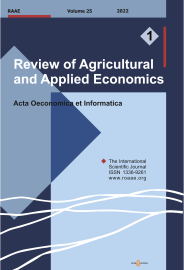KEYWORDS:
Joint-adoption, bivariate probit model, mechanisation, high-yielding varieties, northern Ghana
DOI NUMBER:
10.15414/raae.2018.21.02.41-47
ABSTRACT:
Technology adoption by smallholder farmers is a key strategy to improve agricultural sustainability and productivity in developing countries. This study therefore investigated the factors influencing adoption of agricultural mechanisation and improved varieties by rice farmers in northern Ghana. A bivariate probit model was used to analyse the determinants of farmers’ joint adoption decisions. The results indicated that the age and gender of the household head, the degree of specialisation in production, household size, and location of the farm were significantly associated with farmers’ joint adoption decision. Furthermore, farm size, extension visits, herd ownership and the production system were significant factors in farm mechanisation adoption but not the adoption of improved rice varieties. The study concludes that several individual and household characteristics interplay to influence smallholders’ joint adoption decisions. Hence, efforts to improve rice production in Ghana and other developing countries with similar characteristics should take into account these factors when disseminating innovations to smallholders.
Please Cite this Article as:
Benjamin Tetteh ANANG (2018) Farm Technology Adoption By Smallholder Farmers In Ghana. Review of Agricultural and Applied Economics. XXI (Number 2, 2018): 41-47. doi: 10.15414/raae.2018.21.02.41-47
URL for sharing:
https://roaae.org/1336-9261/doi/abs/10.15414/raae.2018.21.02.41-47
FULL TEXT PDF:
▼ direct download link| view online in fullscreen ▲
References:
▼ direct download link

